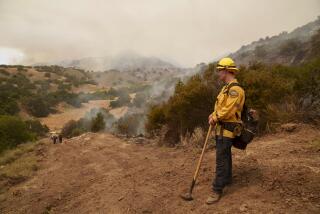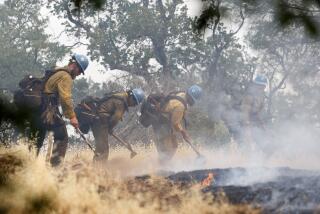Winds Hinder Relief Efforts
- Share via
Temperatures dropped but winds increased Friday as firefighters continued to battle massive mountain brush fires in Los Angeles and Ventura counties, retreating before flames in the Angeles National Forest that forced the evacuation of the mountain community of Green Valley.
The wildfire in Los Angeles County was only 15% contained by nightfall Friday, after charring more than 25,000 acres of brush and timber and destroying at least nine homes.
The blaze was burning in a northeasterly direction from a construction site on Copper Hill Road in San Francisquito Canyon, where a spark from welding equipment apparently touched off the flames Wednesday afternoon.
The outlook was a little better in Ventura County, where the more than 1,100 firefighters manning the lines around a 20,800-acre blaze near Ojai got their first good news since the fire started a week ago.
An onshore flow of moist marine air slowed the advance of flames in most areas, and officials said the fire was 25% contained by sunset.
Despite the continued spread of the Copper Hill fire, no serious injuries were reported and no homes or structures were lost Friday.
Assistant Los Angeles County Fire Chief John Alkema expressed cautious optimism Friday night.
“We haven’t killed this fire yet, but we’ve slowed it down,” he said.
But residents braced for the worst as flames continued to chew up dense brush near and around Green Valley, Warm Springs and other small mountain communities south of the Antelope Valley.
Temperatures climbed into the upper 80s and winds gusted to 25 mph as a squadron of helicopters and planes dumped water and fire retardant.
Below, more than 2,000 firefighters manned lines for 20 miles around the blaze in an effort to save the 400 homes in the Green Valley area.
More than 1,100 residents have evacuated from Green Valley since Thursday, scrambling to retrieve mementos, valuables, pets and livestock before escaping.
Also fleeing the valley were inmates and staff members from county juvenile probation facilities in Lake Hughes.
Officials said parents or guardians of those juveniles can call (661) 940-4122 for information on their whereabouts.
One resident, John Koch, 48, sent his family away in a motor home Thursday before flames burned within 100 feet of his house Friday afternoon.
“The sound was the scary thing,” said Koch, a resident of Green Valley, who spent a sleepless night on the couch. “There was this rush and heat, and it sounded like a waterfall coming at you.”
Suzanne Anaya, 52, found that the fire’s heat peeled paint from the porch of her two-story home off San Francisquito Canyon Road.
Anaya was especially concerned about her dogs and spent 20 hours walking the blackened canyons with a dog whistle to track down one that ran away.
“We really didn’t care about our home,” she said, “we just wanted to save the dogs.”
The Los Angeles County Sheriff’s Department urged residents in Lake Hughes, Lake Elizabeth, Leona Valley and Three Points to evacuate livestock and pets immediately.
In an effort to slow the fire, which was advancing at a rate of four to five miles a day, firefighters set backfires along Spunky Canyon Road and massed fire crews around a cluster of homes at the north end of San Francisquito Canyon Road.
Other crews sprayed foam on vulnerable structures, cut down trees and dismantled wood piles to remove potential fuel for the fire.
The change in weather was a mixed blessing.
Temperatures dropped at least 10 degrees in the fire area Friday, but the cooling came from onshore breezes that fanned the advancing flames.
Los Angeles County Fire Department spokesman Andy Menshek said the fire was contained between San Francisquito and Bouquet canyons, but homes farther north were still threatened.
“There’s an obvious sense of danger and all fire crews are tense because of the unpredictability of the winds,” Menshek said.
In Ventura County, dome tents dotted the makeshift encampment set up for fire crews at Soule Park in Ojai.
Weary firefighters slept under shade trees, the tops of their heads poking from sleeping bags tossed on the grass.
Others played cards, chatted or read as they waited for their next stint on the front lines of the so-called Wolf fire.
Squatting under a tree, U.S. Forest Service firefighter Jack McKenzie sharpened the tool he used to cut fire breaks through the deep brush of the Sespe Wilderness. His face stained with soot, McKenzie had just come from Pine Mountain Ridge, where his 20-member crew from the Tahoe National Forest worked to keep the fire from spreading south of the ridge.
With breezes and dry brush that could keep the fire burning for days, the firefighters are settling in for the long haul, said California Department of Forestry information officer David Drum from Tulare.
The camp at Soule has elements of a war camp, Drum said. While the exhausted firefighters rest, tactical support teams plan attack and defense strategies, studying maps and discussing moves with team leaders on the fire lines.
Help has come from Ventura, Orange, Santa Barbara, Los Angeles and Kern counties, as well as the cities of Montecito, San Luis Obispo, Santa Maria, La Verne and Rancho Cucamonga. Crews have also come from Montana.
Shane Tosse, a firefighter with the Modoc Interagency Hotshot Crew, came down off the mountain Thursday night after a 36-hour shift on the Wolf fire.
“With the way this fire’s burning and how dry it is this season, we’re looking at a rough year,” said Tosse, who operates a chain saw with an elite team of firefighters specially trained to battle blazes in Western back country.
Many firefighters are being airlifted into the fire because of the rugged terrain.
Others face two- to three-mile treks to the fire lines.
Because of the time it takes to get there, many firefighters are putting in 30-hour shifts or longer, Drum said. And he said that after only a few hours of rest at camp, they head out to do battle again.
Eric Jones and his five-member crew were preparing to pull out after five days on the front lines. “We’ll sleep tonight and get ready for the next one,” said Jones.
Forecasters said temperatures in the burn areas shouldn’t climb past the 80s through the weekend, but they said a large trough of low pressure over the Great Basin area could generate some strong, gusty winds in the mountains today and Sunday that could push flames into previously unburned areas and speed the spread of the fires in heavy brush.
*
Times staff writers Andrew Blankstein, Carol Chambers, Elena Gaona, Eric Malnic and Andrea Perera contributed to this report.
More to Read
Sign up for Essential California
The most important California stories and recommendations in your inbox every morning.
You may occasionally receive promotional content from the Los Angeles Times.













